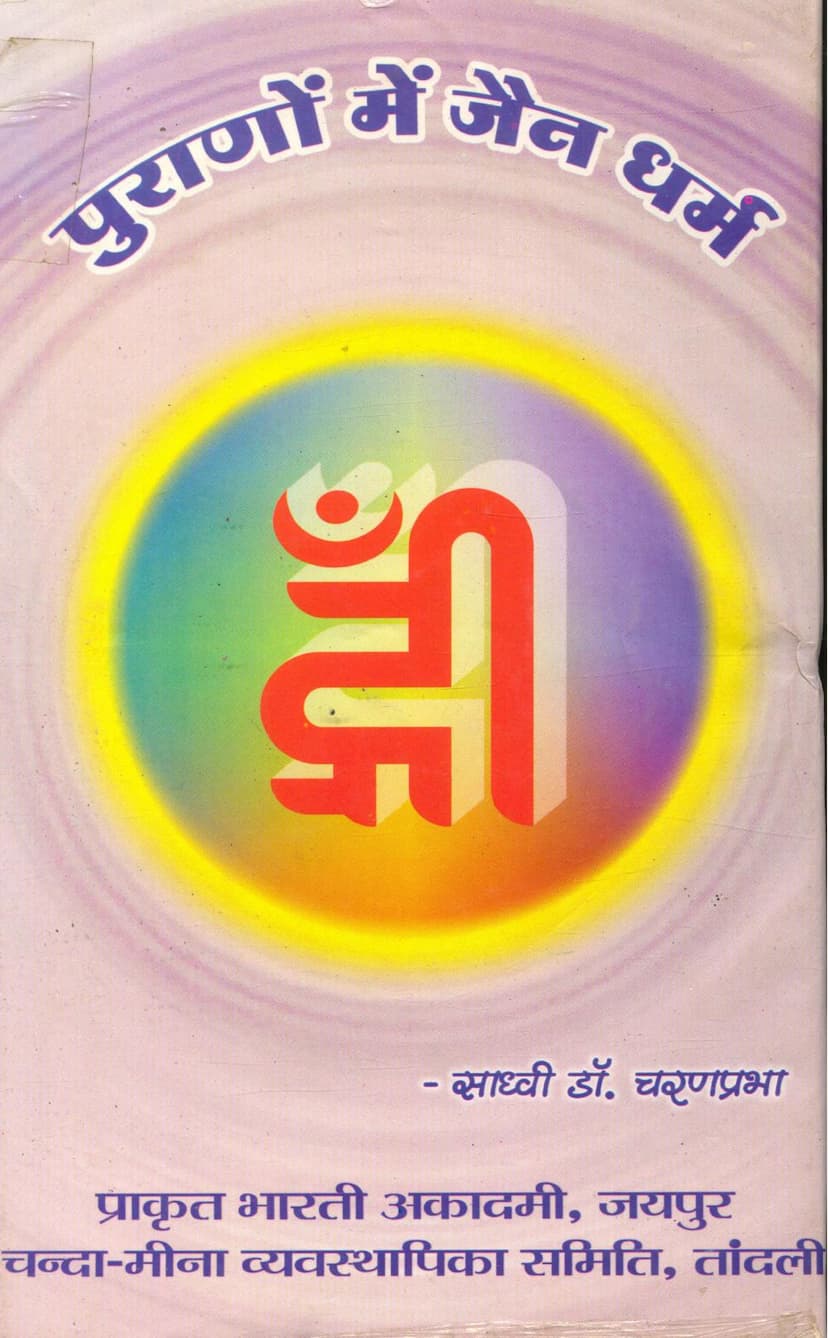Puranome Jain Dharm
Added to library: September 2, 2025

Summary
Here's a comprehensive summary of the Jain text "Puranome Jain Dharm" by Sadhvi Dr. Charanprabhashreeji, based on the provided pages:
This book is a scholarly work by Sadhvi Dr. Charanprabhashreeji, published by Prakrit Bharati Academy, Jaipur. It is a research thesis originally submitted to Jai Narain Vyas Vishwavidyalaya, Jodhpur, for a Ph.D. The book explores the presence and reflection of Jain values, ethics, cultural history, and beliefs within the vast corpus of Indian Puranic literature.
Core Argument and Scope:
The central premise of the book is that despite the apparent differences and separate origins of Vedic (Purana) and Shraman (Jain and Buddhist) traditions, there are significant areas of overlap and mutual influence. The author aims to demonstrate that Puranic literature, often considered a cornerstone of Vedic culture, is surprisingly aware of and incorporates significant elements of Jainism.
Key Themes and Chapters (as indicated by the Table of Contents):
The book is structured into ten chapters, covering a wide range of comparative and analytical topics:
- Introduction: Setting the stage for the research and its importance.
- History of Jainism: Tracing the historical development of Jainism.
- Introduction to Puranas: Providing an overview of the Puranic literature.
- Doctrine of Substances (Dravya-vichar): A comparative analysis of the Jain concept of substances.
- Contemplation of the Self (Atmatatva-chintan): Examining the concept of the soul and self in both traditions.
- Theory of Karma: A comparative study of karma in Jainism and the Puranas.
- Ethical Principles: General Ethics: Discussing common ethical principles like non-possession, truth, penance, and charity, highlighting their shared recognition.
- Ethical Principles: Specific Ethics: Analyzing specific ethical conduct prescribed for householders and ascetics in both Jainism and the Puranas.
- Cosmology (Bhuvan-kosh): Comparing the Jain and Puranic descriptions of the universe.
- Concept of God: Investigating the notion of God in both traditions and identifying potential points of convergence.
- Conclusion: Summarizing the findings and reiterating the book's significance.
Methodology and Approach:
The author, a learned Sadhvi from the Sthanakvasi tradition and a disciple of Acharya Shri Jeetmalji M.S. and Sadhviratna Shri Sheelprabhaji M.S., has undertaken a rigorous historical and Puranic analysis. Notably, the preface highlights that despite her belonging to a specific spiritual lineage, she has approached the subject with an academically objective and unbiased perspective, relying on historical and Puranic evidence. The book aims to uncover the "cooperative aspects" between these seemingly distinct cultural streams.
Significance and Contributions:
- Intercultural Harmony: The book contributes to the understanding of the historical and philosophical dialogues between the Sanatana (Vedic/Puranic) and Shramana (Jain and Buddhist) traditions, emphasizing their potential for cultural and spiritual synthesis.
- Unveiling Jain Presence in Puranas: It provides detailed, evidence-based analysis demonstrating how Jain principles, cosmology, and history are embedded within Puranic narratives.
- ** Scholarly Rigor:** The research is praised for its thoroughness, drawing upon various Jain scriptures, Puranas, and other relevant texts.
- New Perspectives: The author's nuanced approach, which focuses on finding common threads rather than solely highlighting differences or attributing influence in one direction, is considered commendable. It offers a fresh perspective on the interconnectedness of Indian religious thought.
- Value for New Generation and Researchers: The book is intended to be informative and engaging for general readers, while also serving as a valuable reference and source of inspiration for researchers.
Key Findings and Observations (from the introductory and prefatory sections):
- The book acknowledges the inherent fluidity and syncretic nature of Indian culture, where different ideologies can flourish and influence each other while maintaining their unique identities.
- It draws a parallel between the complementary streams of cultural integration and coexistence that have characterized Indian civilization since time immemorial.
- The author's research aims to counter the historical tendency of sectarian conflict and instead promote understanding and shared heritage.
- The book suggests that Puranic literature, while reflecting Vedic traditions, also contains extensive material related to Jainism, sometimes even offering "Vedic interpretations" of Jain values.
- There's an emphasis on Jainism's antiquity, supported by references to its mentions in non-Jain texts and archaeological findings.
- The book highlights shared concepts like "Ahimsa Paramo Dharmaḥ" (Ahimsa is the highest religion), the importance of renunciation (Nivritti), the concept of "Sat" (being) with its attributes of production, decay, and permanence, and the idea of the soul as conscious and distinct from the material world.
- Similarities are noted in Puranic and Jain cosmologies, ethical principles (five vows, similar virtues), the concept of the soul, karma, and even certain aspects of theistic beliefs, albeit with differing interpretations of an "creator" God.
- The work aims to demonstrate that Puranas are aware of Jainism by referencing "Arhat Dharma" and mentioning Jain Tirthankaras.
In essence, "Puranome Jain Dharm" is a significant work that seeks to bridge understanding between two major streams of Indian religious thought, revealing the often-overlooked integration and shared ethical and philosophical foundations between Jainism and the Puranic tradition.